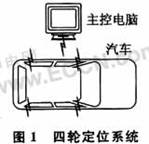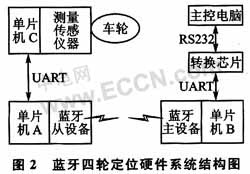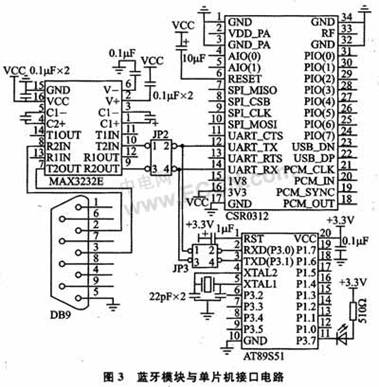introduction In recent years, with the rapid development of China's auto industry and the substantial increase in car ownership, auto inspection technology has also made tremendous progress. The functions and quality of auto inspection equipment are constantly improving, and it is gradually becoming digital, intelligent, and portable. Development direction. As the basic equipment for automobile inspection, the four-wheel locator is a device specially used to measure wheel positioning parameters. The common four-wheel locators on the domestic market are mainly wire-pulled and wireless measurement wired transmission. The future development trend is all-wireless. How to use low-cost wireless transmission technology to transform the existing wired data transmission system has become a very meaningful issue in engineering. In this paper, a low-cost wireless transmission Bluetooth technology is used to propose a scheme to transform the existing four-wheel positioning system of automobiles, and the software and hardware design methods of the four-wheel positioning system of wireless automobiles are described in detail. 1 Problems and solutions of traditional design 1.1 Problems with traditional design When the car leaves the factory, the positioning angles of its suspension system are all set, but these positioning angles will change after the vehicle is driven for a period of time. The positioning system is a main control computer and four sensors installed on four wheels. During the test, the four-wheel locator measures the current four-wheel positioning parameters of the car, and transmits the data back to the main control computer; the main control computer will display the car measurement data list, and compare with the original data to calculate the deviation value Then adjust the relevant parts of the car appropriately. The traditional automobile four-wheel locator relies on the wired method to communicate with the main computer, and it has many limitations in use. The four-wheel locator is expensive, and the domestically produced ones are generally more than RMB 100,000, while the imported ones are more expensive, generally more than RMB 200,000. So to make it wireless, the best solution is to keep the original hardware system, and only add the hardware and software of the wireless transceiver unit, so as to avoid the second investment of the car repair station. 1.2 Wireless solution Industrial occasions often need to transmit data wirelessly. For example, the ultra-high temperature furnace used for drawing crystals in fiber manufacturing needs to transmit the temperature data. The Bluetooth module is small, free from obstacles and angles, and its price is relatively low, which is more suitable. In addition to some dedicated Bluetooth modules, most Bluetooth module hardware provides data interfaces, and can transmit real-time data with low speed requirements through the RS232 serial port. This article chooses Bluetooth technology to design a wireless traditional car four-wheel positioning system. Bluetooth works in the free ISM frequency band, and the transmission power is relatively small (generally 1 ~ 10 mW), it will not cause radio interference to other electrical equipment in the car repair station, which is very suitable for car maintenance applications. Bluetooth adopts a point-to-point or point-to-multipoint master-slave network solution, and the Bluetooth four-wheel positioning network uses a master device and 4 slave devices, as shown in Figure 1. This is because modern cars are generally independent of front and rear suspension, so the parameters to be adjusted for the front and rear wheels are independent. The point-to-point scheme of one master and one slave cannot be adopted, and the scheme of one master and four slaves is required. 2.1 Overall hardware design The Bluetooth master device is a master computer with wireless transceiver function, which is responsible for querying the status of the four wheels and sending adjustment commands to the four wheels; the Bluetooth slave device is four measuring and sensing instruments installed on the wheels of the car and is responsible for measuring the four wheels. Status parameters, and wirelessly transmit the measured parameters back to the host computer. The standard data of the model is stored in the main control computer. It wirelessly receives the data from the four wheels (that is, the current four-wheel positioning parameters of the car), compares with the stored value of the model to calculate the deviation, makes corresponding judgment, and then The adjustment commands are sent wirelessly to the four rounds. According to this requirement, the hardware system structure is shown in Figure 2. The single-chip microcomputer C and the measuring and sensing instrument in Fig. 2 belong to the traditional automobile four-wheel locator before wireless. The measuring instrument measures the angle of the car wheel and other parameters, and sends it to the single-chip C through the sensor. The process of transmitting the state parameters of the four wheels back to the main control computer is as follows: MCU C obtains the data of the wheel sensor and transmits it to MCU A through the UART port; MCU A sends the data wirelessly from the device to the Bluetooth master device of the main control computer via Bluetooth; MCU B After obtaining the data from the Bluetooth master device, it is converted into a standard RS232 serial port form through the conversion chip, and then sent to the main control computer through the standard 9-pin serial port on the PC. The process of the host computer sending adjustment commands to the four rounds is similar. In this way, it is only necessary to add some components to the traditional four-wheel positioning system to achieve wireless, which is convenient for automobile maintenance companies. 2.3 Interface circuit design of Bluetooth module and single chip microcomputer The Bluetooth module adopts CSR Company's Bluecore series CSR0312. The main technical specifications are as follows: â—† RF output is class2, and the working distance is 10 m; â—† Bluetooth 1.1 certification; â—† FCC & ETST certification; â—† Support UART interface. The single-chip computer is used to store the instruction code for initializing the Bluetooth module and establishing the wireless ACL data connection. It can be said that the software in the single-chip computer is the core of this system. AT89S51 is adopted here, which is relatively inexpensive. The conversion chip uses MAX3232E. The circuit connection for transmitting instructions is shown in Figure 3. The UART interface of the Bluetooth module is used as the data transceiver interface RXD and TXD to communicate with P3.0 and P3.1 of the AT89S51. AT89S51 exchanges data with Bluetooth module CSR0312 through these two interfaces, and sends host control interface commands to it. AT89S51's P1.2 and P1.3 are used as extended serial interfaces to communicate with other MCUs; P3.2 is used as an external interrupt entry. When data is transferred from other MCUs, it will trigger an interrupt to start receiving data. The Bluetooth module communicates with the microcontroller through the host control interface HCI. Using the host control interface instructions, the Bluetooth module can enter a given mode of operation (such as querying other devices on the network or establishing a data connection). In this way, the Bluetooth module can be controlled by a single chip microcomputer to realize wireless data transmission. The Bluetooth commands to establish an ACL connection and disconnect are: MOV DPTR, #HCICreateACLConnecTIon After the Bluetooth module receives the #HCICreateACLConnecTIon signal, it will enter the mode of establishing an ACL connection. The software flow of the master device and the slave device is basically the same, the difference is that the master device needs to query the slave device and establish the ACL data link, but the slave device does not have this part of the work. The program flow of the master device is shown in Figure 4. After the system starts, the master device must first query the slave device. After receiving the response from the slave device, it can know whether it can establish a Bluetooth network with the slave device and determine which of the four tires the Bluetooth slave device represents; then the master device The device initiates a connection request, establishes a wireless ACL link, prepares to send and receive data, and notifies the arrival of data using an external interrupt. After the four-wheel positioning is completed, the master computer sends an end signal, and the Bluetooth module connected to it interprets the signal as disconnecting the Bluetooth connection, notifying the slave device to cancel the Bluetooth network, and the process ends. 4 Summary Although the range of the Bluetooth module is not large, usually not more than 10 m, it is acceptable for four-wheel positioning. If necessary, the effective distance can also be increased by increasing the transmission power. In general, the Bluetooth module has low cost and flexible networking; compared with the wired four-wheel positioning system, the price has not increased significantly, but the flexibility of use has greatly increased. The test results show that Bluetooth technology is applied to the four-wheel locator, which not only improves the system stability and working efficiency, but also facilitates the use of the equipment, and can be well adapted to the harsh environment of the car repair place. High-Speed 3D Filament Extrusion Line,Precision 3D Filament Extrusion Line,Customizable 3D Filament Extrusion Line,Advanced 3D Filament Extrusion Line Technology Zhejiang IET Intelligent Equipment Manufacturing Co.,Ltd , https://www.ietmachinery.com
2 System hardware design 
2.2 Hardware workflow
â—† Comply with Bluetooth 1.1 specification; 
3 System software design
...
MOV DPTR, #HCIDisConnect
... 